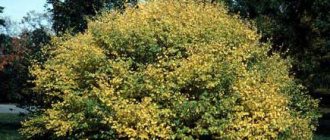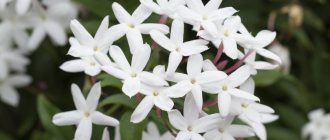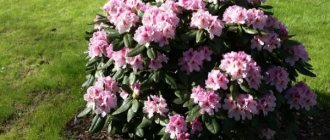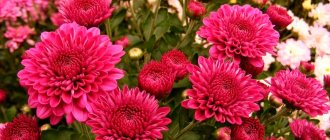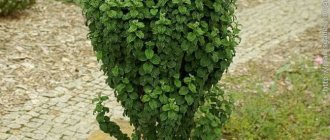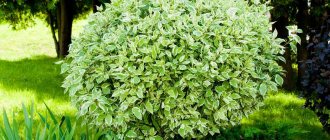Author: Elena N. https://floristics.info/ru/index.php?option=com_contact&view=contact&id=19 Category: Fruit and berry plants Published: August 31, 2016Last edits: November 02, 2020
- How to care in spring
- When to prune
- Reproduction methods
- Blue elderberry
- Medicinal properties of black elderberry
The elderberry bush (lat. Sambucus) belongs to the genus of flowering plants of the Adoxaceae family, although previously it was included in the Honeysuckle family and even allocated to the Elderberry family. There are about forty species in the genus, some of them are medicinal plants - for example, black elderberry and red elderberry, and some are ornamental. In nature, elderberry grows mainly in Australia and in temperate and subtropical climate zones of the Northern Hemisphere. Elderberry has been known to mankind since ancient times - the ancient Greeks made musical instruments from its shoots, and it was mentioned in the works of Pliny.
Planting and caring for elderberry
- Planting: in spring (before the buds swell) or in autumn, in early October.
- Flowering: May-June.
- Lighting: bright light.
- Soil: moist loamy or soddy-podzolic with pH 6.0-6.5.
- Watering: during drought - once a week at a consumption of 10-15 liters of water per bush. Young bushes require more frequent watering.
- Fertilizing: in spring and in the first half of summer - nitrogen fertilizers (slurry, infusion of chicken manure, urea), from the second half of summer - potassium-phosphorus. In autumn, elderberries are not fed.
- Pruning: annual in spring, along dormant buds, or during leaf fall.
- Reproduction: seeds, cuttings, layering and dividing the bush.
- Pests: aphids.
- Diseases: not affected.
Read more about growing elderberries below.
Where does it grow
Siberian elderberry is distributed in the east of the European part of Russia, in Western and Eastern Siberia, in the Far East, North Korea, Mongolia and northern China. It can often be found in coniferous and mixed forests, on the slopes of ravines, and along river banks. The plant prefers slightly acidic and neutral soils. The composition of the components contains a significant content of clay and sand. Although the plant's winter hardiness is not high, thanks to its intensive growth the bushes quickly restore their crown.
Botanical description
Most of the representatives of the genus are small trees or shrubs, but there are also perennial herbs in the genus, for example, herbaceous elder. In the middle zone, 13 types of elderberry are cultivated, and the most common plant is the black elderberry, a description of which we bring to your attention.
Like most species in the genus, black elderberry is a shrub or small tree 2 to 6 m high, growing in the undergrowth of deciduous and coniferous forests, sometimes forming entire thickets. Elderberry stems are branched, with a thin woody shell and a porous, soft white core. Young elderberry branches are green, but over time they become brownish-gray with a large number of small lenticels. Elderberry leaves are large, from 10 to 30 cm long, imparipinnate, consisting of several oblong, long-pointed leaves on short petioles, located oppositely.
Fragrant elderberry flowers of a cream or dirty yellow hue, 5-8 mm in diameter, are collected in large multi-flowered corymbose flat inflorescences up to 25 cm in diameter. Elderberry inflorescences appear in May or June. Elderberry fruits are almost black berry-shaped drupes up to 7 mm in diameter with dark red flesh and 2-4 seeds. Fruiting begins in August or September.
- Why should you not burn the leaves, and how can they be used beneficially?
Elderberry is in demand not only in amateur gardening, but also in folk medicine, so we will tell you how to grow this shrub in your garden, and describe the medicinal properties of elderberry and contraindications that you should know about.
Chemical structure
Elderberry fruits contain:
- glucose;
- fructose;
- free acids (mainly malic acid);
- vitamin C;
- tanning agents.
Dried leaves contain provitamin A.
Black elderberry inflorescences contain:
- mucous substances;
- malic, acetic and valeric acids;
- paraffin-like substance;
- solid essential oil;
- terpene and glucoside;
- having the diaphoretic effect of rutin.
The flowers of this plant have unique properties.
Planting elderberry
When to plant
Planting and caring for black elderberry is not much different from planting and caring for any other shrub. Elderberry is planted in spring or autumn. The best planting material is one- or two-year-old elderberry seedlings.
Where does elderberry grow? Elderberry is an unpretentious plant, but if you plant it in deep shade or poor soil, this will negatively affect both its appearance and development. Find an open, well-sunny spot for the elderberry on the northern or eastern edge of the site, especially if you plan to grow an ornamental variety with variegated or colored leaves. Traditionally, elderberry, whose young shoots have an unpleasant odor that even repels flies, is planted near toilets, cesspools or compost pits.
As for the composition of the soil, the optimal soil for elderberry is moist loam or soddy-podzolic soil with a pH in the range of 6.0-6.5 pH. Acidic soils will have to be limed by adding dolomite flour, and this should be done two years before planting the elderberry.
Spring planting
When planning to plant an elderberry seedling in the spring, prepare a hole 80 cm deep and 50 cm in diameter for it a month in advance. When digging, throw the soil from the top layer to one side, and from the bottom to the other. If you intend to grow elderberry as a tree, drive a stake into the center of the hole of such length that it rises about half a meter above the surface of the plot. Elderberry grown as a bush will not need support. Mix fertile soil from the top layer with 7-8 kg of humus, add 50 g of phosphates and 30 g of potassium fertilizers to the soil mixture and, after mixing thoroughly, pour two-thirds of this mixture into the hole.
On the day of planting, loosen the soil cushion at the bottom of the hole, lower the seedling into it and first sprinkle its roots with soil from the bottom layer, and on top with the rest of the soil mixture with fertilizers. As a result, the root collar of the seedling should be several centimeters above the level of the site. After planting, compact the soil in the tree trunk circle and water the seedling with 10-15 liters of water, and after it is absorbed, the soil settles and the root collar is flush with the surface of the site, tie the seedling to a peg.
Planting in autumn
Autumn planting of elderberry is carried out in the same order and according to the same rules as spring: a hole is dug in advance and filled with organic matter and fertilizers, after which the elderberry seedling is planted so that the root collar, after watering and settling the soil in the hole, is flush with the surface plot.
Species diversity
Within the genus Sambukus, which includes the black elderberry, it is difficult to make a species classification due to the widespread distribution of the shrub and its morphological diversity.
According to various classifications, the family includes 9-40 different perennial herbaceous plants, bushes, bushes and even trees.
Both wild species (used as medicinal raw materials) and cultivated ornamental varieties are known.
Elderberry care
How to care in spring
In March, trees and shrubs may suffer from sunburn - the bark becomes very hot under the bright spring sun, and at night there is a sharp cooling. To prevent the consequences of this phenomenon, the trunks and forks of the skeletal branches of elderberry are covered with a layer of lime. If damage caused by rodents in winter is found on the bark, disinfect it with a strong solution of potassium permanganate and cover it with garden varnish.
On warm, fine days, you can start pruning the elderberry, and after that treat the bush with a solution of Nitrafen or Bordeaux mixture against diseases and pests that managed to overwinter in the bark or soil under the bushes and trees. The tree trunk circles are freed from insulating material and last year's leaves. If the winter was snowless and the spring was dry, carry out moisture-recharging watering of the elderberry.
Summer care
After elderberry blooms, the bush is sprayed against pests and powdery mildew.
At the beginning of summer, plants begin to actively grow and form ovaries, so the most important task is to provide the garden with moisture and nutrition. The soil in tree trunk circles must be kept loose and moist. In bushes that are frozen in winter, root growth begins to grow, which must be immediately destroyed before it outstrips the bush itself. To prevent the elderberry from spreading throughout the garden, you can dig old slate around the bush at a distance of one and a half meters and to a depth of half a meter.
In August, elderberries are already beginning to ripen on some bushes, and you should be ready to harvest. At the end of summer, it is necessary to create conditions to prepare the bushes for wintering: a rainy summer can cause secondary growth of shoots, which can only be stopped by removing the mulch from under the bushes and pinching the tops of the growing shoots.
Autumn elderberry care
Caring for elderberries in the fall is preparing them for winter. In September, the elderberry harvest continues, after which sanitary pruning of the bush is carried out. At the end of the month, they dig up the soil in the tree trunk circles, apply fertilizers, and, in dry autumn conditions, carry out pre-winter watering of elderberries. If you are just planning to plant elderberries, dig holes for the seedlings at the end of September and fill them with fertilizers.
- Grapes: forming new sleeves - what you need to know
In October, the bushes are treated from pathogenic microorganisms and pests that have settled for the winter in the bark of branches or in the soil under the bush, and trunks and large branches, in order to protect them from winter rodents and spring burns, are whitened with freshly slaked lime or chalk with the addition of copper sulfate and carpentry glue. Tree trunk circles are insulated with peat, humus or dry leaves.
As soon as the snow falls, throw it under the bush - this will be the best protection for the elderberry from frost.
Treatment
Twice a year - in early spring, before buds open, and after leaf fall - elderberry bushes and the soil under them are treated for preventive purposes with a one percent solution of Bordeaux mixture or a two to three percent solution of Nitrafen. They do this in order to destroy fungal infections or harmful insects hidden for the winter in the bark or in the top layer of soil.
Instead of these drugs, you can use a one percent solution of copper sulfate or another drug of similar effect. A seven percent urea solution, if treated with it in the spring, acts not only as a fungicide and insecticide, but also as a nitrogen supplement needed by the plant at this time of year.
Watering
Rainy summers and mulch around the tree trunk, which does not allow moisture to quickly evaporate, can save you from watering elderberries. It is best to mulch the soil around the elderberry bush with compost or rotted manure. In summer with normal rainfall, you will not need to water the elderberry, but in dry, hot times, pour 10-15 liters of water under the elderberry bush once a week. Young plants are watered more often. Do not let the soil under the bushes dry out. After watering or rain, it is very convenient to loosen the soil around the bushes and remove weeds.
Top dressing
In fertile soil, elderberry grows well without fertilizing, but it responds very well to nitrogen fertilizers applied in spring and summer to poor soil. Of the organic fertilizers, elderberry is best accepted by slurry and chicken manure infusion. She is also favorable to urea and complex mineral fertilizers. In autumn, elderberries are not fed.
Other uses
The bush serves as an excellent way to prevent small rodents and other household pests from coming close to your home. The smell from broken stems and torn elderberry leaves repels them.
In gardening areas and houses, elderberry is often used instead of a soap product with a natural effect. When rubbed, the fruits perfectly remove dirt from the surface of tables and also cleanse hands.
Elderberry is used to produce green dye, oil is made from the seeds, and alcohol products are also made from the berries. Also, elderberry involves the production of dye and ink. Sometimes you can find jams or preserves made from ripened berries.
Elderberry pruning
When to prune
Like many garden plants, elderberry requires annual sanitary and formative pruning. Once every three years, to rejuvenate the bush, all branches are cut to a height of 10 cm. It is best to prune the elderberry during the dormant period - in early spring, before the buds on the branches begin to swell. True, sometimes sanitary pruning of elderberries is required in the fall, after harvesting and leaf fall.
Spring pruning
In a newly planted seedling, the shoots are shortened by 10 cm to the strong outer bud. By its nature, the shape of the elderberry crown is neat, oval - so maintain it in this form by cutting out branches and shoots that grow inside the bush or at the wrong angle. Dry, diseased, weak and frostbitten shoots are also subject to removal. The root growth must be removed while it is in its infancy. Every year, a quarter of the old branches are cut back to the base of the bush. The cuts must be lubricated with garden varnish.
Pruning in autumn
If during harvesting some elderberry branches were injured, carry out sanitary pruning, simultaneously removing diseased and improperly growing shoots along with the damaged ones. If there is no such need, prune only in the spring.
As you can see, planting and caring for elderberries is simple and not labor-intensive, but the benefits of elderberries, which we will discuss in a separate chapter, are undeniable.
Classification
Representative of the Adoxaceae family. Previously, it was classified in the genus “Honeymacaceae” and was even separated into a separate genus “Elderberry”. Latin name Sambucus nigra L.
Other names:
- basenik;
- elderberry;
- elderflower;
- Sambuca;
- Swiss tea;
- wasteland;
- girlish sambuca.
Black elderberry belongs to a small number of species (400) of the honeysuckle family
Elderberry propagation
Reproduction methods
Elderberry is propagated by seeds, cuttings, dividing the bush and layering. Unfortunately, seed propagation almost never preserves the varietal and even species properties of elderberry, so most often the plant is propagated vegetatively.
Growing from seeds
Elderberry seeds are collected in the fall, in mid-October, by rubbing the ripe fruits through a sieve. Sow the seeds in rows, the distance between which is about 25 cm. The sowing depth is 2-3 cm. By the end of the next season, the seedlings will grow to 50-60 cm.
Propagation by cuttings
Harvested in June or early July, green cuttings 10-12 cm long with two or three internodes and a pair of upper leaves, on the petiole of which only two paired segments are left, are planted in a mixture of sand and peat in equal parts and covered with a high polyethylene cap so that create greenhouse conditions for the cuttings. Before planting, do not forget to treat the lower cuts with a root former - it will increase the rooting ability of the cuttings by 2-3 times.
To create the required level of air humidity, during the first 4-6 days, spray the film from the inside with water from a fine spray, being careful not to let the drops fall on the leaves of the cuttings, as this can cause them to rot. In autumn, rooted cuttings are planted in the ground.
- Autumn work in the raspberry field
If necessary, you can also root lignified one-year-old cuttings, which are harvested at the end of the growing season, stored in the winter in snow or a basement, and in the spring planted in loose, fertilized soil in the garden and each of them is covered with a glass jar or plastic bottle with the neck cut off until until the cuttings grow roots.
Reproduction by layering
This method of reproduction gives almost one hundred percent survival rate. For layering, either young green or two- to three-year-old woody shoots are used, which are bent to the ground, placed in pre-made grooves, a little compost is placed in each of them, the shoots are secured with a metal hook and dug in, leaving the tops above the surface.
If you place woody cuttings in grooves in May or early summer and tie them at the base with wire, they can be separated from the bush in the fall and planted. Green shoots are not tied with wire and are removed from the mother plant not in the fall, but only the next year, when they become lignified.
Dividing the bush
This method of propagation is carried out in the fall. An adult, large elderberry bush is dug up and divided into approximately equal parts. You may need to use an ax or saw to split the elderberry root. Each division must have developed roots and shoots. The cuts and cuts are treated with wood ash and the sections are immediately planted in holes prepared in advance. You can plant them in containers and postpone planting in the ground until spring. Dividing the bush makes it possible to immediately obtain a large plant.
Landscape design
The plant is widely used in garden and park architecture due to its versatility (it harmonizes well with almost any type of landscape architecture) and high decorative value. Often used as single plantings when decorating and landscaping the corners of fences or walls of buildings.
Related article:
Cinquefoil bush
Plantings of several types of shrubs, which can be combined in height, type of foliage and their color scheme, look original and beautiful.
When independently planning and decorating the green area of your personal plot, you should pay attention to the following points:
- Pruning the bush to obtain the required shape will make it possible to replace with elderberry some types of plants that are capricious in growing, as well as those that are not typical for the region.
- Planting seedlings in a row around the perimeter as a hedge can be used as an alternative to a fence. By pruning branches, you need to independently regulate its height and appearance. Such plantings can create an additional barrier to the wind and protection from viewing the site from the street, as well as limit the flow of vehicle exhaust gases from the roadway.
- Low varieties of shrubs are combined in an original way with hawthorn, conifers, barberry and buddleia.
Types and varieties of elderberry
In addition to black elderberry, a dozen more species are grown in our climate, and we will introduce you to the most interesting of them.
Blue elderberry
An ornamental plant that naturally lives along the banks of streams and rivers, as well as in mountain pastures in North America. Trees of this species sometimes reach 15 m in height, and sometimes grow as shrubs with thin branches that have a red tint when young. The trunks of blue elderberry are light sandy in color, the leaves consist of 5-7 bare, bluish-green coarsely serrated leaves up to 15 cm long. Fragrant cream flowers are collected in a corymbose inflorescence up to 15 cm in diameter, which blooms for about 3 weeks.
Elderberry berries are blue, spherical, bluish-black due to a bluish bloom, and look very impressive. The frost resistance of this species is below average.
Siberian elderberry
It grows naturally in East Asia, the European part of Russia, in Eastern and Western Siberia and the Far East, preferring mixed and dark coniferous forests and rising up to 2200 m above sea level. This is an ornamental shrub up to 4 m high with average winter hardiness.
Elderberry herbaceous
It grows wild in Ukraine, the Caucasus, Belarus and the south of the European part of Russia, choosing rocky screes and river banks. This foul-smelling, but beautiful herbaceous plant during flowering and fruiting reaches a height of 1.5 m. The berries of the herbaceous elderberry, which form scutes on the tops of the shoots, are poisonous when fresh, as they contain hydrocyanic acid.
This species is sometimes planted around the currant tree, since the herbaceous elderberry drives away all harmful butterflies and bud mites, but then it can be very difficult to remove this plant with a thick creeping rhizome from the currant tree. Dried elderberry flowers have a pleasant smell; they are sprinkled on apples stored for storage.
Elderberry
Grows naturally in moist, nitrogen-rich soils of eastern North America. This highly ornamental plant, reaching a height of 4 m, is often used in landscaping. The shoots of plants of this species are yellowish-gray, the leaves are large - up to 30 cm in length, small fragrant flowers of a yellow-white hue form slightly convex umbrella-shaped inflorescences up to 25 cm in diameter, and the edible spherical shiny fruits are colored dark purple. This species has been in cultivation since 1761. It is very similar to black elderberry, but is much more resistant to the conditions of the middle zone.
Elderberry has several decorative forms - maxima (the most powerful of all forms), acutiloba (graceful, with strongly dissected leaves), chlorocarpa (with yellowish-green leaves and green berries) and aurea (with bright yellow leaves in spring and autumn and green in summer).
Red elderberry
Or racemosus, native to the mountains of Western Europe. This is a tree up to 5 m high or a deciduous shrub with a dense ovoid crown, light green odd-pinnate leaves up to 16 cm in length, consisting of 5-7 elongated and pointed leaves with sharp teeth along the edges. Greenish-yellow flowers are collected in dense oblong inflorescences up to 6 cm in diameter. The fruits are small bright red berries. Both leaves and branches have an unpleasant odor. The plant is very beautiful during the fruiting period. In culture since 1596.
This species has the following decorative forms:
- low – dwarf, compact plants;
- thin-leaved - this variety has purple leaves when opening, cut into very narrow segments, so the plant looks very elegant;
- purple - with purple or pink flowers;
- yellowish - this variety has yellow fruits with an orange side;
- dissected leaf – the most commonly cultivated variety of red elderberry with early-blooming large leaves consisting of 2-3 pairs of finely dissected leaves;
- pinnate - with purple serrated leaves when blooming, dissected almost to the middle. Popular varieties of this variety are Plumosa Aurea with openwork leaves that are yellow in the sun and green in the shade, and Sutherland Gold with even more dissected yellow leaves.
Elderberry Zimbold
It is found naturally in Japan, the Kuril Islands, Sakhalin and the Far East, and in Western Europe it is cultivated as an ornamental plant. This is a spreading bush or tree up to 8 m high. This species is similar to the red elderberry, but it is much more powerful: the leaves, consisting of 5-11 parts, reach a length of 20 and a width of 6 cm. The inflorescences are also larger than those of the elderberry racemose, but more loose. This species has been in cultivation since 1907.
Black elderberry, described in detail in the article, also has several popular decorative forms:
- Guincho Purple is a shrub up to 2 m high with green leaves at an early age and black-purple leaves in maturity, which turn red in autumn. The flowers in bud are deep pink, but when open they are white with a subtle pink tint. The shoots of plants of this variety are purple. All these advantages appear only in the sun - in the shade the bush remains green;
- Marginata is a fast-growing bush up to 2.5 m high with fragmentary silver-cream edging on the leaves;
- Pulverulenta is a slow-growing shrub with showy leaves dotted with white spots, stripes and streaks.
Decorative forms, as a rule, are less frost-resistant than the main type, but they look great in the garden both as a tapeworm and in a group with other plants.
Regions of growth
It is found in subtropics and temperate climates, in:
- Tunisia;
- Algeria;
- Europe;
- Iran;
- Turkey.
Elderberry grows mainly in Australia and the Azores, in the temperate and subtropical climate zones of the Northern Hemisphere.
Elderberry feels good in Ukraine, the Baltic states, Belarus, Crimea, the Caucasus, in the southwestern regions of Russia and in southern Siberia.
Regions of distribution on the map of Russia
Properties of black elderberry - harm and benefit
Medicinal properties of black elderberry
Elderberry inflorescences contain valeric, acetic, caffeic, malic and chlorogenic organic acids, tannins, semi-solid essential oil, choline, carotene (provitamin A), mucous and paraffin-like substances, sugars. The properties of elderberry flowers are truly unique.
Elderberries contain ascorbic acid (vitamin C), carotene, malic acid, resin, glucose, fructose, amino acids and coloring matter.
Fresh black elderberry leaves contain carotene and ascorbic acid, essential oil, tannins, resinous substances, and dried leaves contain provitamin A1.
The bark contains choline, essential oil and phytosterol.
An infusion of dried elderberries (1:10) stimulates bile excretion, enhances diuresis and intestinal motility. Elderberry flower tea relieves bronchitis, laryngitis, neuralgia and flu. It is also used as an anti-inflammatory mouthwash.
In folk medicine, not only the berries, but also the flower of the elderberry, as well as the leaves and bark of the plant have long been used. Elderberry flowers were used to make infusions and decoctions that had a diaphoretic and antibacterial effect. They are still used in the treatment of colds, flu, sore throat and upper respiratory tract diseases.
An infusion of black elderberry flowers is prepared as follows: pour a tablespoon of flowers into a glass of hot water, bring to a boil, cook over very low heat for 15 minutes, then cool, filter, squeeze and drink half a glass before meals 2-3 times a day for rheumatism, gout or arthritis. A lotion is prepared from elderberry flowers that tones and rejuvenates the skin: 10 elderberry inflorescences are poured with two glasses of boiling water, left for a day, filtered and stored in the refrigerator.
Elderberry leaves have astringent, antipyretic, sedative, diuretic and laxative effects. When used externally in steamed form, they relieve diaper rash, hemorrhoids, boils and burns. And to treat constipation, young elderberry leaves are boiled in honey.
A decoction is prepared from elderberry bark, which is used to treat kidney and skin diseases, gout, rheumatism and arthritis.
In addition, jam, jelly and wine are made from elderberry.
Contraindications
But no matter how useful this plant is, you can still sometimes hear about the harm of elderberry. In these cases, they mean the fruits of red elderberry, which not only cannot be eaten, but after them you must wash your hands with soap. If their juice gets into scratches on the skin or cracks in the mucous membrane, consult a doctor immediately.
As for black elderberry berries, their use is not recommended for pregnant women suffering from colitis, diabetes insipidus and chronic stomach diseases. Elderberry is contraindicated for people with Crohn's disease and with individual intolerance to this berry.
Keep in mind that at certain times it is very difficult to distinguish harmful red elderberry berries from the healing black elderberries, so unless you are absolutely sure which plant you are dealing with, it is better not to take risks.
Amazing Features
There is a popular belief that elderberry can:
- relieve diseases and misfortunes;
- attract wealth and prosperity;
- protect the family;
- promote the creation of harmony between spouses;
- protect against betrayal and betrayal;
- banish anxiety;
- save garden crops from pests;
- give the owner of the talisman determination, perseverance, courage and determination.
About the healing abilities of the bush, the English writer of the 17th century, John Evelyn, argued that if they knew all the healing properties of the leaves, flowers, berries, and bark of the elderberry, then there would not be a single disease or wound left that could not be cured by black elderberry.
His statement is confirmed by the fact that even today all the components of the tree are used in alternative medicine:
- fruits help get rid of problems of the gastrointestinal tract, gall bladder, and urinary tract;
- a herbal decoction from the bark cures gout and skin diseases, promotes wound healing, and is a hemostatic agent;
- the leaves are used in the preparation of kidney preparations;
- A cough herbal decoction is prepared from the rhizome;
- Flower tinctures have antioxidant and tonic effects. And lotions made from them rejuvenate the skin;
- juice obtained from fresh fruits - against constipation and varicose veins.



